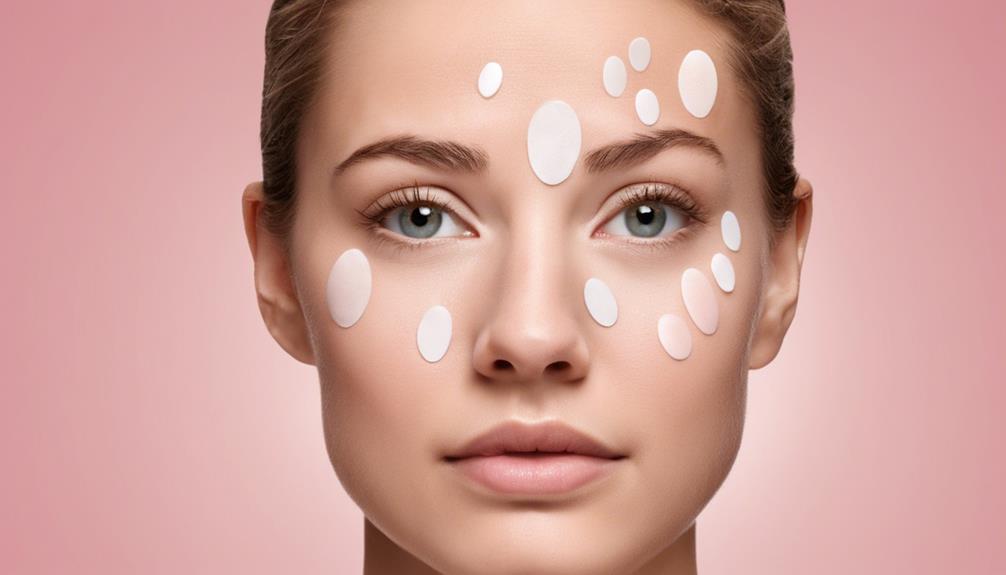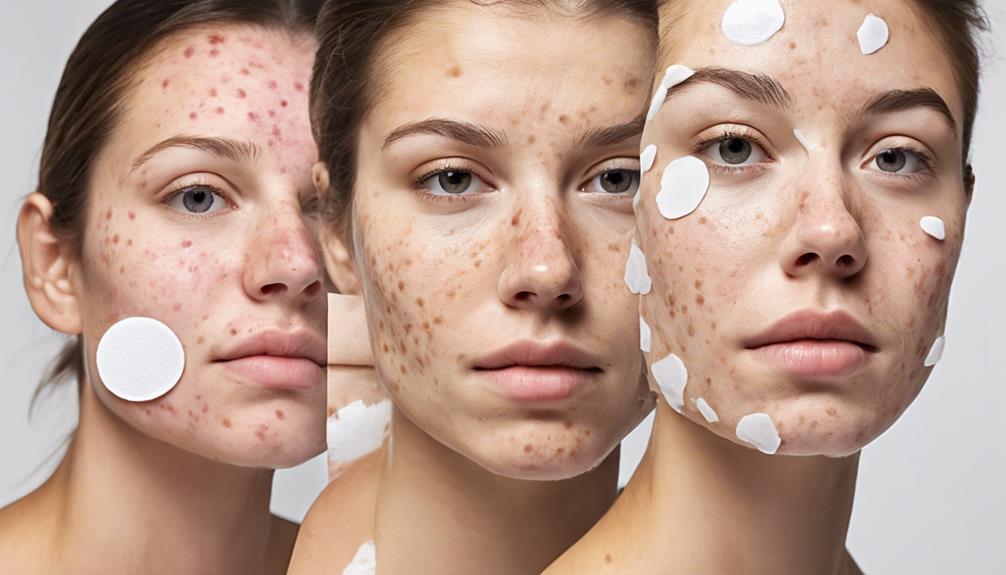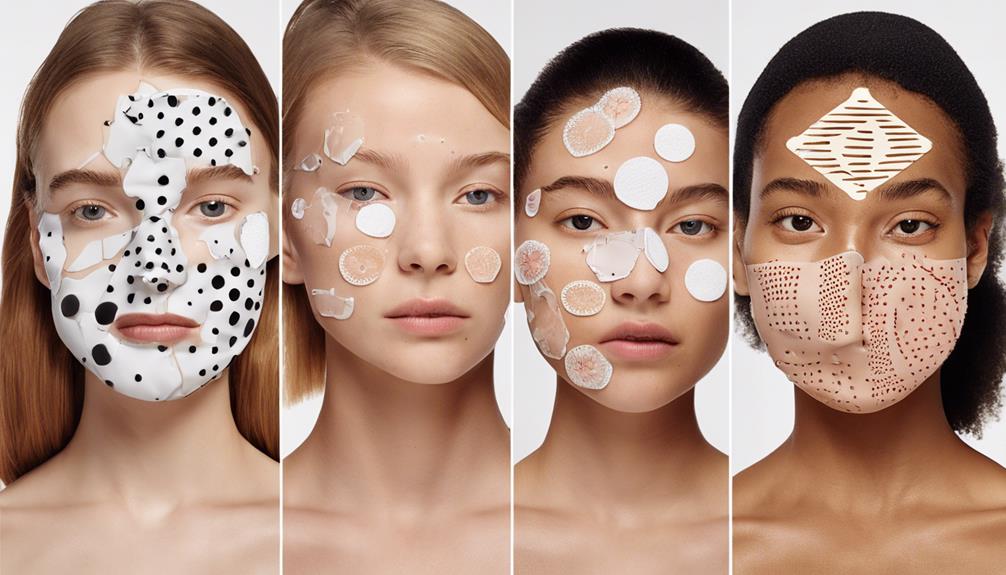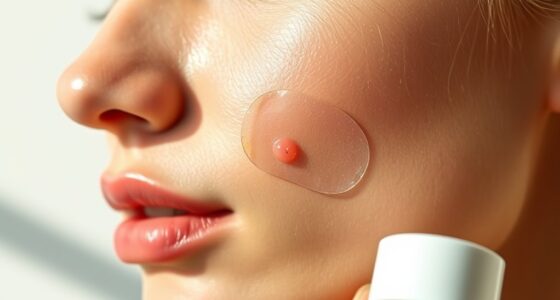You should keep a pimple patch on for 6 to 8 hours for best results. If you’re dealing with stubborn blemishes, you can wear it for up to 24 hours. It’s essential to apply the patch on clean, dry skin to maximize absorption. Always check for indicators like a white appearance, which signals it’s time to remove the patch. Stick around to discover more tips for effective acne treatment and skin care.
Key Takeaways
- Wear pimple patches for 6 to 8 hours; sensitive skin may benefit from 4 to 6 hours for optimal results.
- Some patches can be left on for up to 24 hours, especially for stubborn pimples.
- Ensure skin is clean and dry before application to maximize patch effectiveness.
- Monitor patches for color changes; a white appearance indicates saturation and the need for removal.
- Regularly replace patches to maintain absorption and avoid irritation from saturated patches.
Understanding Pimple Patches: What Are They?
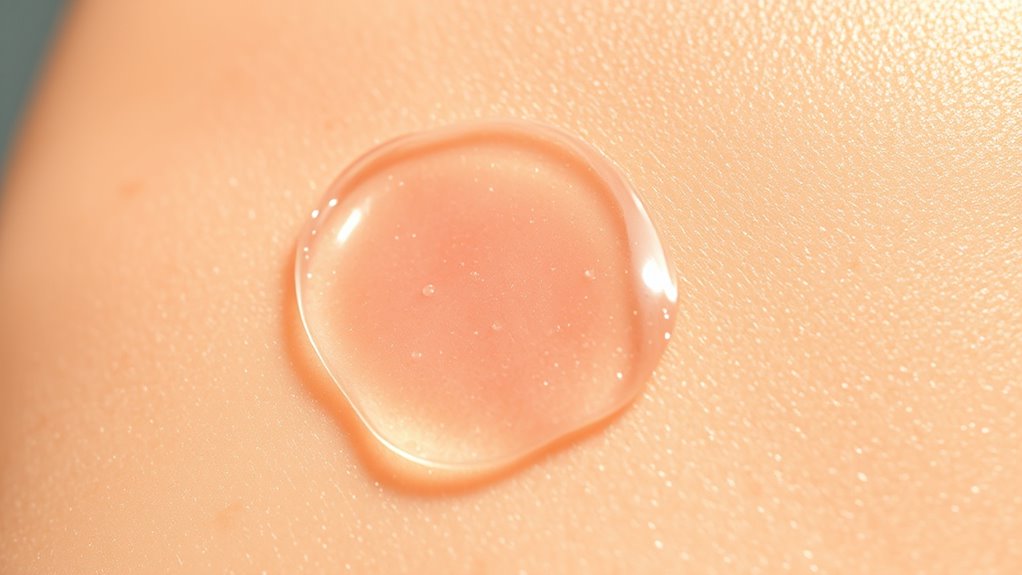
Pimple patches are your go-to solution for treating acne lesions like pimples and whiteheads. These small adhesive patches are typically made from hydrocolloid, a material that absorbs fluids while keeping the area moist. By creating a protective barrier, they prevent irritation and contamination from external factors. Not only do they treat existing blemishes, but they also help prevent new ones by absorbing excess oil and protecting the skin. You can find a variety of patches infused with ingredients like Salicylic Acid, Tea Tree Oil, or Niacinamide to enhance their effectiveness. Hydrocolloid patches are ideal for treating whiteheads and help flatten them overnight, making them an essential addition to your skincare routine. Additionally, some patches are specifically designed for cystic acne treatment, making them a versatile tool in your skincare arsenal. When selecting patches, consider those that are infused with essential oils which can enhance their healing properties while being gentle on the skin. Whether you have oily or sensitive skin, there’s a patch type that suits your needs, making them a versatile tool in your skincare arsenal.
Standard Application Time for Pimple Patches
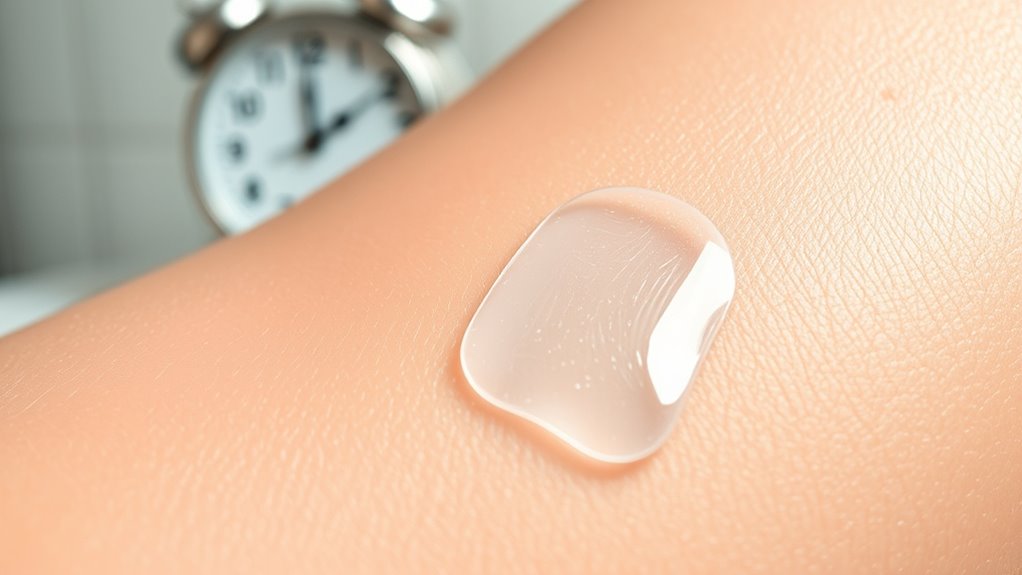
For ideal results, it’s best to leave pimple patches on for 6 to 8 hours. This duration allows the patch to effectively absorb impurities, especially if you’re dealing with whiteheads. A clean, dry face enhances patch effectiveness against bacteria.
If you have sensitive skin, consider wearing the patch for 4 to 6 hours to avoid irritation. Some patches can be worn for up to 24 hours, but longer times are usually more effective for larger blemishes.
Verify your skin is clean and dry before application for best adhesion. Signs it’s time to remove the patch include a white or cloudy appearance, loss of adhesion, or visible improvement in your pimple.
Overnight Use: Maximizing Effectiveness
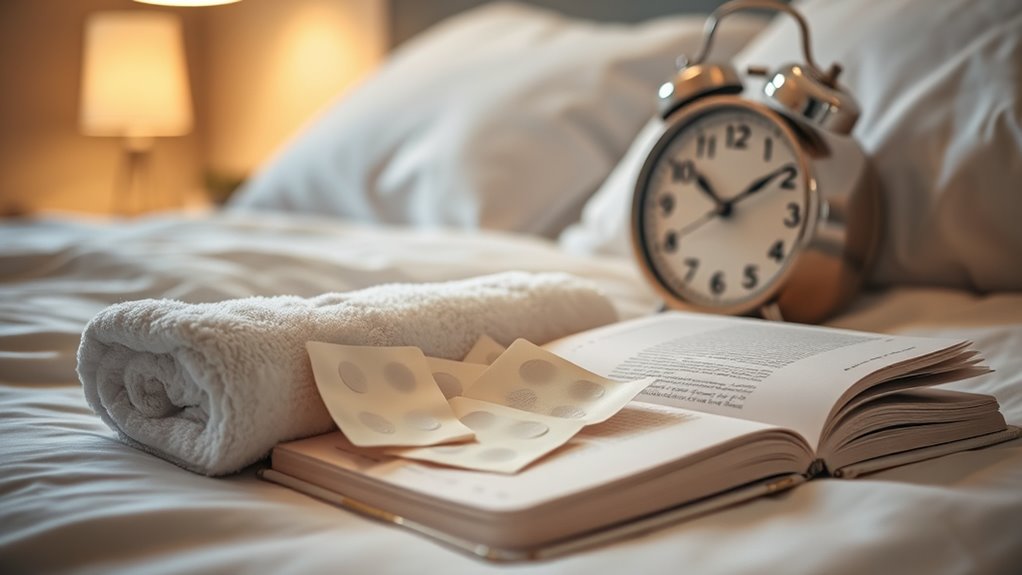
When you apply a pimple patch overnight, you’re giving it the chance to work its magic for an extended period, typically between 8 to 12 hours. This extended healing time allows the patch to absorb impurities without disturbance, maximizing its effectiveness in reducing pimple size and inflammation. Plus, applying it at night is convenient, ensuring it stays in place undisturbed. By morning, you’ll often notice visible improvements, like reduced redness and size. Wearing a patch also protects against picking, which can irritate your skin and lead to scarring. For the best results, make sure your skin is clean and dry before application, and choose patches designed specifically for overnight use. Additionally, the patch creates a moist environment that speeds up healing, preventing scabs and scars.
Factors Affecting Patch Duration
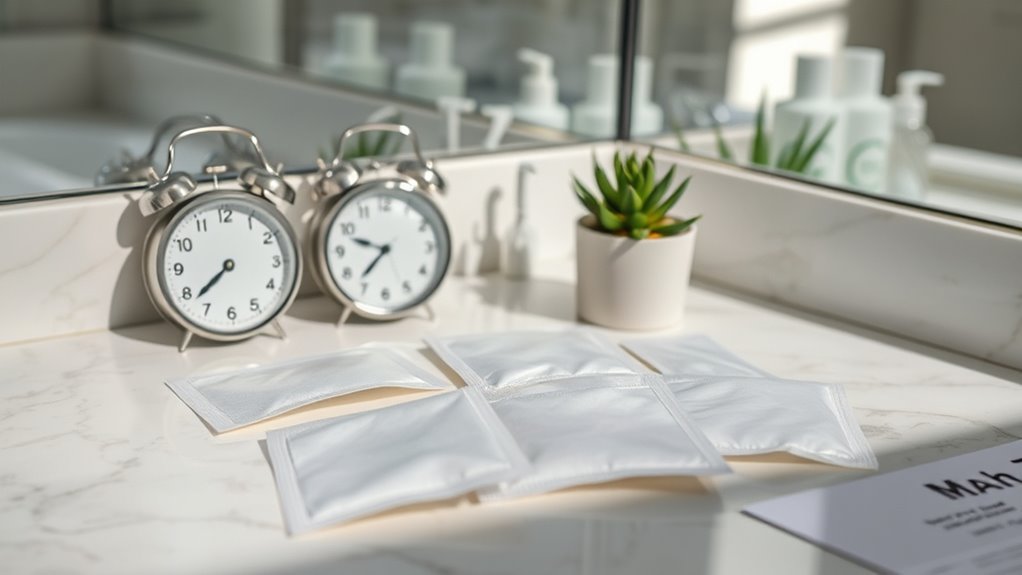
Several factors can influence how long you should keep a pimple patch on to achieve the best results.
The type of acne matters—whiteheads respond well to hydrocolloid patches, while cystic acne may require longer wear for inflammation reduction. It’s important to note that pimple patches are generally recommended for occasional use and should not replace professional acne treatment.
The patch formulation also plays a role; medicated patches might need shorter durations, while those infused with soothing ingredients can be more flexible.
Your skin type and sensitivity are essential too—oily skin needs clean, dry surfaces for adhesion, while sensitive skin may require shorter wear times.
Finally, consider the severity of blemishes; larger, inflamed pimples often benefit from extended use.
Always follow manufacturer instructions for ideal effectiveness.
Benefits of Using Pimple Patches
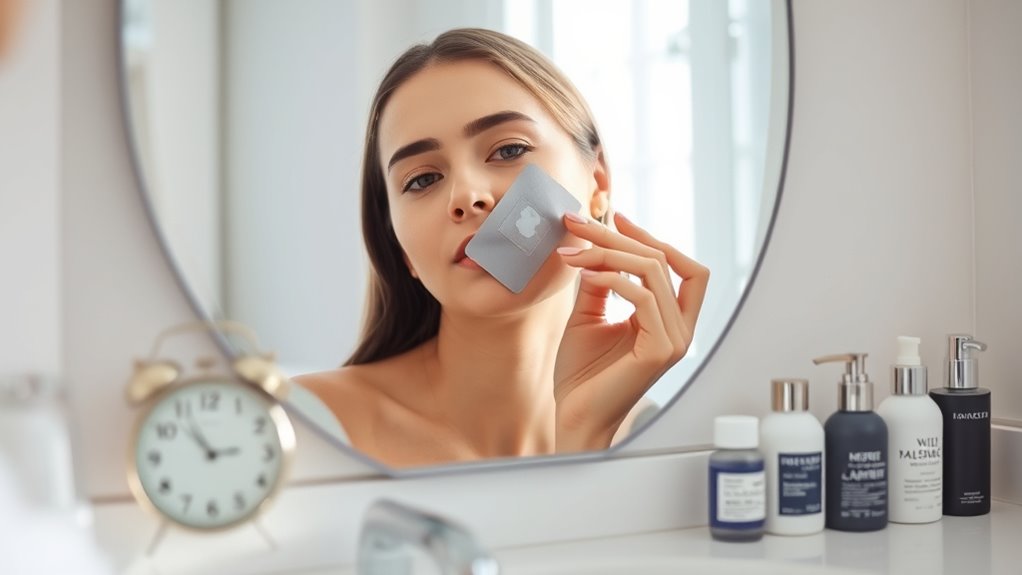
Pimple patches offer a range of benefits that can enhance your acne treatment routine. They reduce inflammation by drawing out pus and excess fluid, thanks to their hydrocolloid material. Acting as a barrier, these patches protect your skin from external irritants like dirt and bacteria, preventing further irritation. They also create a moist environment that aids the healing process. With various designs, pimple patches can be discreet and even stylish. Additionally, by covering the pimple, they help reduce the temptation to pick or pop, minimizing the risk of scarring. Active ingredients like salicylic acid and tea tree oil further boost their effectiveness, making them a valuable addition to your skincare arsenal. Furthermore, hydrocolloid patches aim to allow skin to heal naturally while minimizing infection risk.
Tips for Applying Pimple Patches Effectively
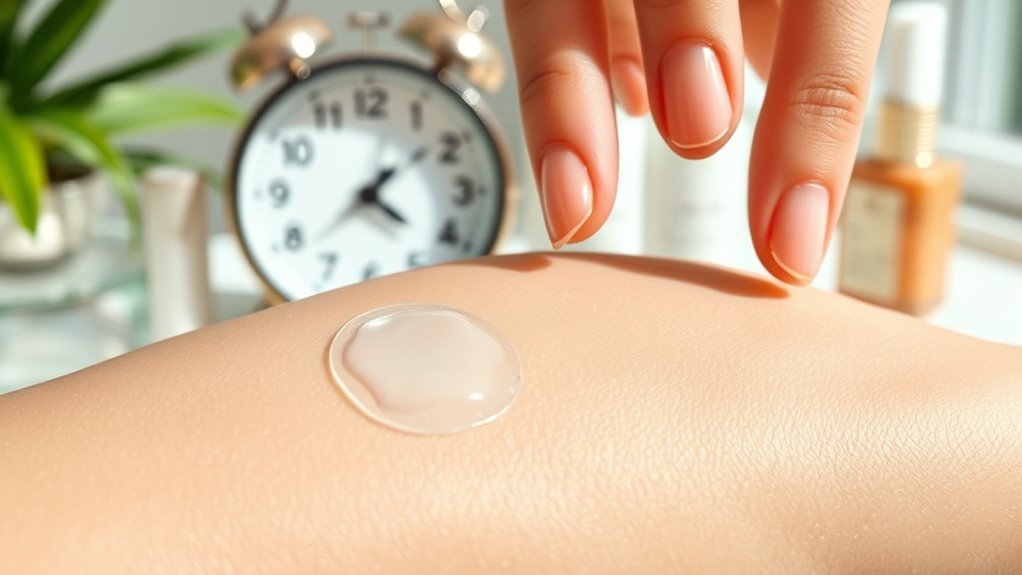
To achieve the best results with pimple patches, start by properly preparing your skin. Use a gentle, oil-free cleanser to remove any sebum, sunscreen, or makeup. Pat your skin dry with a towel—don’t rub, as that can irritate your skin. Make certain your hands are clean before touching the patch or the affected area to avoid bacteria transfer. Select a patch that fully covers the pimple for maximum effectiveness, and opt for transparent patches if you plan to wear makeup. Apply the patch directly on the clean, dry pimple, pressing gently for 10-30 seconds to verify it adheres well. Avoid air bubbles to keep it in place, and apply patches after cleansing but before other products for best adhesion. This method ensures you benefit from targeted, convenient treatment for your breakouts.
Different Types of Pimple Patches
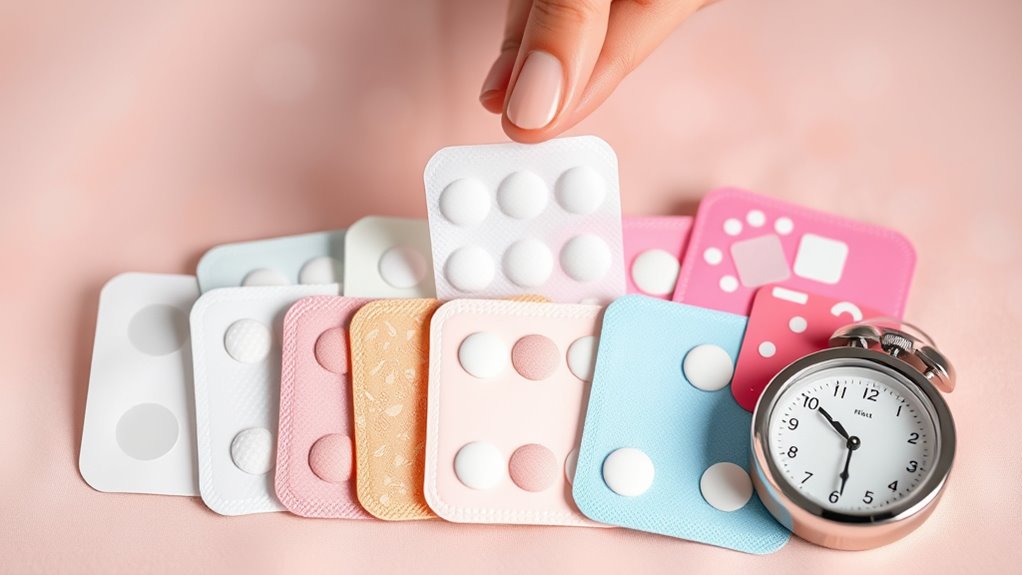
Applying pimple patches effectively sets the stage for choosing the right type for your skin’s needs.
Hydrocolloid patches are the most common, absorbing excess fluid and promoting healing. If you’re dealing with bacteria and inflammation, consider medicated patches containing ingredients like salicylic acid. For deeper pimples, microneedle patches deliver active ingredients directly into the skin. Non-medicated patches focus on protection and absorption without added skincare elements. Additionally, many patches are made of hydrocolloid material, which helps draw out fluids and creates a moist environment for healing. You can also find patches with special features, such as hyaluronic acid or tea tree oil, for extra benefits. When selecting a patch, keep your specific acne type in mind; hydrocolloid works well for pustules and whiteheads, while non-hydrocolloid options are better for cystic acne. Hydrocolloid technology is especially effective for promoting healing by drawing out impurities.
Choose wisely for clearer skin!
Common Mistakes to Avoid With Pimple Patches

When using pimple patches, it’s easy to make mistakes that can diminish their effectiveness.
First, make sure you apply patches to clean, dry skin—applying them over skincare or makeup can reduce adhesion.
Also, don’t forget to pick the right type of pimple; patches work best on whiteheads. Hydrocolloid patches absorb excess fluid from pimples, which aids in faster healing.
Leaving patches on for too short or too long can either limit their effectiveness or cause irritation, so aim for at least six hours.
Replace patches when they become saturated; leaving them on too long won’t help.
Finally, integrate patches early in your routine to maximize results.
Avoid these common pitfalls, and you’ll enhance the effectiveness of your pimple patches for clearer skin.
Monitoring Patch Indicators for Removal
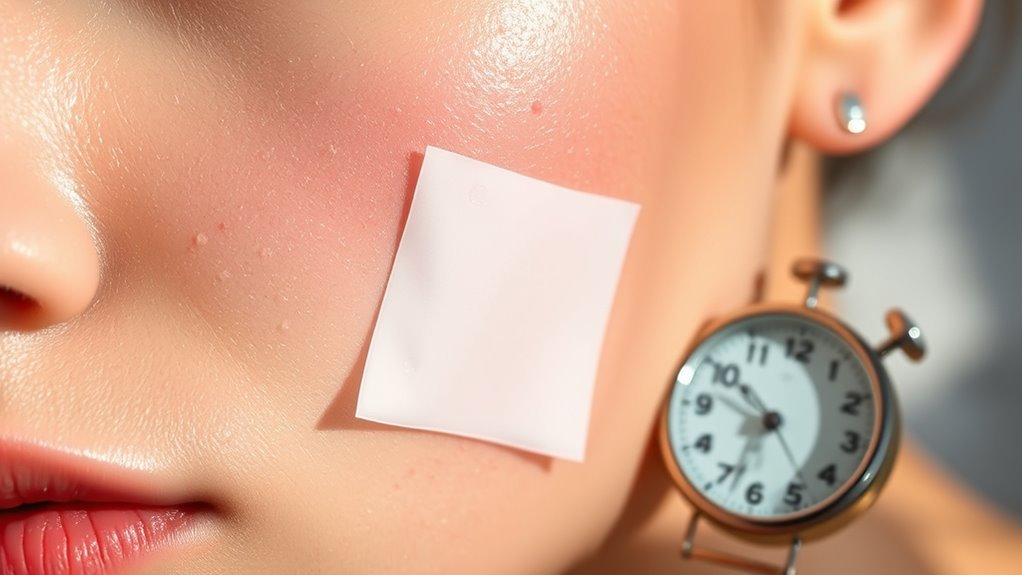
As you monitor your pimple patch, keep an eye on color changes and adhesion to determine the right time for removal. A patch that turns white or cloudy signals it’s effectively absorbing fluids and may be saturated. Replace it when this happens.
Aim to wear the patch for at least 6 to 8 hours, ideally overnight, for best results. Also, check its adhesion; if the patch starts peeling or if you notice irritation like redness or itching, remove it immediately. Utilizing hydrocolloid patches can enhance the healing process by creating a moist environment for the blemish.
Applying patches to clean, dry skin enhances their stickiness. Regularly replacing patches helps maintain absorption and protection, promoting clearer skin.
Adjusting Usage Based on Acne Severity and Skin Type
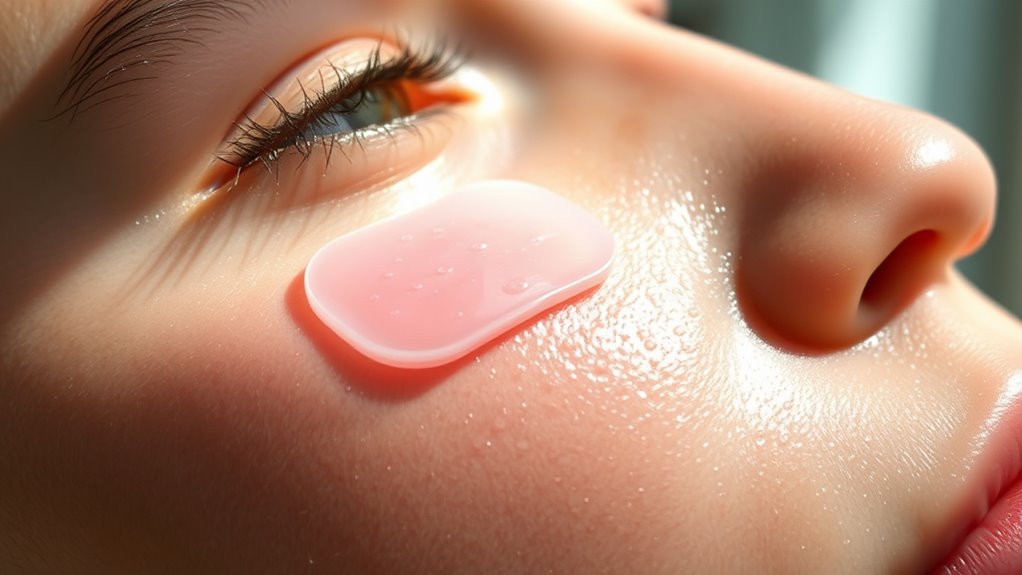
To achieve the best results from your pimple patches, it’s essential to adjust their usage based on the severity of your acne and your skin type.
For whiteheads, aim for 6-8 hours of wear to maximize effectiveness. If you’re dealing with stubborn pimples, consider extended use up to 24 hours or patches with microneedles. This approach allows for maximum absorption of impurities and promotes faster healing.
For cystic acne, longer durations may help reduce inflammation, but these patches won’t penetrate deeply. If you have sensitive skin, start with shorter wear times to avoid irritation. Choose patches with soothing ingredients for delicate areas.
Integrating patches into your routine consistently will help manage breakouts and improve overall skin health. Tailoring your approach guarantees you get the most out of your pimple patches.
Frequently Asked Questions
Can I Use Pimple Patches on Cystic Acne?
You shouldn’t use pimple patches on cystic acne.
These patches are designed for surface-level breakouts, like whiteheads, and won’t penetrate deep enough to address cystic lesions. Instead, they might irritate your skin or trap bacteria, potentially worsening the situation.
For cystic acne, consider consulting a dermatologist for effective treatments like oral medications or specialized topical solutions.
Focusing on thorough care will help manage your skin better in the long run.
Do Pimple Patches Work on Body Acne Too?
Oh, you thought pimple patches only worked on your face? Surprise! They’re equally effective on body acne.
These patches absorb impurities and protect your skin, making them a great option for those pesky breakouts elsewhere.
Just slap one on a clean, dry area, and let it work its magic.
While they mightn’t tackle cystic acne, they’ll help with those annoying surface blemishes, giving you clearer skin in no time!
How Do I Know if a Patch Is Effective?
To know if a pimple patch is effective, check for signs of absorption. If the patch turns white or cloudy, it’s likely absorbed fluid and impurities.
You should also notice reduced swelling and redness around the pimple. If you don’t experience irritation or itching, the patch suits your skin.
Can I Wear Makeup Over Pimple Patches?
Yes, you can definitely wear makeup over pimple patches! They create a smooth surface, making your makeup application more even.
Just make sure your skin is clean and dry before applying the patch. When you apply makeup, use a light touch to avoid moving the patch, and choose a matte concealer that matches your skin tone.
This way, you can conceal breakouts while allowing the patch to work its magic without interference.
Are Pimple Patches Safe for Sensitive Skin?
Pimple patches are like magic for sensitive skin! They create a healing environment while protecting against irritants.
If you’re using Neutrogena patches, you’re in good hands—they’re dermatologist-recommended and peel off gently.
Just be sure to start with a shorter wear time, like 4-6 hours, to check for irritation.
Always apply them on clean, dry skin, and follow up with moisturizer after removal for happy, hydrated skin!
Conclusion
In the journey to clear skin, pimple patches serve as your shield, battling breakouts while you sleep. By applying them for the right duration, you harness their power, transforming pesky pimples into distant memories. Remember, each patch is a tiny warrior, and monitoring its signals helps you know when to retire it. Embrace this tool wisely, and soon you’ll find your complexion flourishing like a garden after a gentle rain, vibrant and clear.



